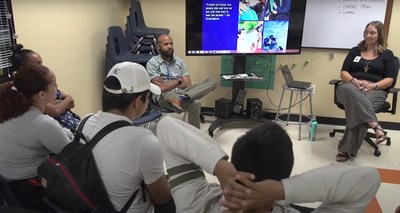Schools Need to Address Student Trauma During and After Distance Learning

LOS ANGELES, May 13, 2020 /PRNewswire/ — Every teacher in every school has students who have experienced or are living with trauma in their lives – and that trauma may be escalating with distance learning.
Learn4Life, a network of charter schools that focuses on at-risk students, emphasizes the need to support students’ social-emotional health and help them cope in this uncertain time. Some students struggle to continue their studies in a less structured environment while feeling isolated or distracted. And many suffer continuous, recurring traumas that increase when they are forced to stay home.
“We like to say that before you can reach a student’s head to learn, you have to reach their heart and earn their trust,” said Dr. Caprice Young, national superintendent. “Traumatized children who learn to thrive have someone in their lives who encourages them and believes in their success.”
She points out that all school leaders can educate teachers on a trauma-informed approach to learning – during this pandemic – and beyond.
- Recognize your own feelings first. Just like on an airplane, you must put on your own air mask before you can help others. Acknowledge the grief and change we are all experiencing. Take care of yourself so you can offer calm and empathy to students.
- Stability with flexibility. In times of change and uncertainty, consistency with flexibility is important. Some teachers might need to communicate with their students in the evening to accommodate the student’s work or child-care schedule.
- Just listen and validate honestly. Adults often want to “fix” things, when instead a student just wants to be heard and supported. Instead of saying, “don’t feel bad” or “be strong,” acknowledging their feelings is the best way to earn trust and build a relationship.
- Encourage students to ask for help. Be there when they reach out for support but know when you need to refer the student to another professional such as child/adult protective services, mental health specialists or law enforcement. Let students know that you will support them throughout the process, and then follow through.
- Set appropriate expectations. Recognize each student’s abilities and current circumstances or barriers before setting expectations. Be clear about what you expect and your confidence in the student’s ability to rise to the occasion. Notice and celebrate each success, no matter how small.
- Remind them they are not alone. Even though they may sometimes feel they are. Research shows that when adversity feels like a shared experience, we cope better – not only emotionally, but neurologically.
Watch a video about Learn4Life’s trauma-informed approach to education.
Dr. Caprice Young is national superintendent for Learn4Life, a nonprofit network of schools that serves at-risk high school students and former dropouts through a flexible and personalized learning model (not seat-based, one-on-one blended learning). In response to COVID-19, the network moved its 23,000+ full-time students in CA, OH and MI to remote learning within 48 hours, providing meals, social/emotional support, diapers/formula for parenting students, and devices and hotspots as needed.
About Learn4Life
Learn4Life is a network of nonprofit public schools that provides students personalized learning, career training and life skills. Each school is locally controlled, tuition free and gives students the flexibility and one-on-one attention they need to succeed. Serving more than 49,000 students – including full-time and intersession students – we help them prepare for a future beyond high school. We are proud to be a GuideStar Platinum Seal of Transparency recipient for our ethical, transparent and effective organizational practices. For more information, please visit www.learn4life.org.
MEDIA CONTACT
Ann Abajian, Learn4Life
(844) 515-8186
PR@learn4life.org
View original content to download multimedia:http://www.prnewswire.com/news-releases/schools-need-to-address-student-trauma-during-and-after-distance-learning-301058455.html
SOURCE Learn4Life


